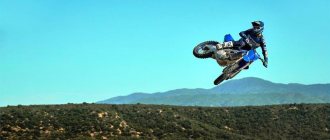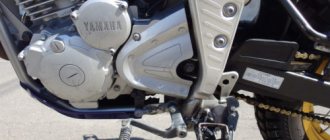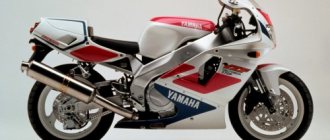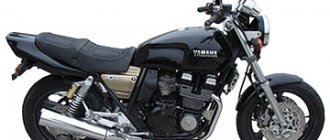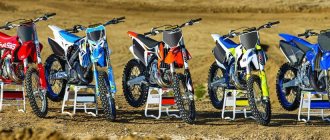Yamaha TDM 900 (2001–2010, RUB 200,000–400,000)
The old man Yamaha TDM, aka “Tygydym”, back in 1991, then still in the 850 cc version, made an attempt to break the mold in relation to the classification of motorcycles (a little earlier the idea was tested on the Yamaha TDR-350, but that’s a completely different story). Marketing and other hassles have never been so common. The engineers just wanted to experiment. In their own way, they mixed the design features and habits of a touring enduro, a regular road motorcycle and a sporty naked bike. The resulting equipment was classified as a funbike for a long time. TDM 850/900 found its consumer, but never became super popular. The model was finally discontinued in 2010 without any regret.
Engine
Organ donation in relation to the engine is attributed to the Yamaha XTZ750 Super Tenere tour enduro. Initially, the two-cylinder in-line 10-valve carburetor engine with liquid cooling and a dry-sump lubrication system was “inflated” to 849 cm3, then in 1996 it received a crankshaft design simulating a V-shape from the Yamaha TRX850. Then with 77 hp. With. at 7500 rpm up to 80.2 liters. With. at 7500 rpm peak power increased. During the next modernization in 2002, the power unit received another 49 cm3 of displacement and electronic fuel injection with variable intake tract geometry instead of a pair of carburetors, which led to an increase in peak power to 86 hp. With. at 7500 rpm.
Unlike the early modifications, which suffered from a whole bunch of diseases associated with capricious carburetors (up to their shooting out of their homes due to reverse popping into the intake), gearbox, clutch, fuel pump and increased oil waste, the “900” there is practically nothing to incriminate. Its engine contains a heavier crankshaft, Nikasil, new connecting rods and modified camshafts. Which has a beneficial effect on the torque curve, stability and smooth operation. The engine of the TDM 900, unlike its predecessors, consumes almost no oil, vibrates very slightly and does not twitch during transient conditions.
Transmission
The gearbox and clutch are one big headache for the owners of 850 cc Tygydyms. There is frequent overheating and slipping of the clutch, as well as slurred operation of the gearbox. With the arrival of the Yamaha TDM 900, engineers tried to solve all known transmission problems. The gearbox has been redesigned. A sixth stage appeared, with the first gear becoming shorter and the last gear longer, the rest becoming closer to each other. The clarity of the unit's operation and the smooth running of the motorcycle have increased significantly.
Frame and body kit
The steel frame (1991–2001) is almost impossible to break; falls and driving with a load that exceeds the permitted load do not cause cracks to appear. The same applies to early generation rims; it takes a lot of effort to crush them. The aluminum frame (2002–2010) with removable rear subframe is a slightly more fragile design. Just like the wheels and plastic used on the 900.
Brakes
Throughout its existence, the TDM 850/900 did not shine with its braking system. He always had anachronisms. Through all the years of production, the same scheme has passed - two 298 mm discs with four-piston calipers at the front, one 245 mm disc and a two-piston caliper at the rear. Only the calipers were changed. The situation improved somewhat in 2002 with the arrival of calipers from the early YZF - R 1. In 2005, the motorcycle began to be equipped with an anti-lock braking system, and therefore the “A” index was added to the name.
Pendants
The suspension elements of the Yamaha TDM 850/900 fit perfectly with a calm riding style and react extremely negatively to “motorcycle racing”. The 850s were equipped with a conventional indestructible telescope and a monoshock absorber without progression links at the rear. In 1996, the diameter of the front fork was increased from 41 mm to 43 mm, stiffness increased slightly, and travel decreased. In the case of the 900, a monoshock absorber with compression and rebound adjustments is installed at the rear, and a 43-mm “telescope” at the front.
Comfort
Comfort behind the wheel of the Tygydym is a rather relative value. The high-mounted handlebars and low-mounted footpegs create the correct posture for long distances with an absolutely straight back. However, due to the small amount of plastic, there is a noticeable lack of wind protection. To the disadvantages, it is worth adding the fact that the engine constantly vibrates finely, forcing the driver to dismount and warm up more often than usual.
Modifications
The Yamaha TDM850 (often called the Yamaha TDM850-1) first appeared in 1991. In 1993, there was a slight restyling - the muffler became chrome instead of black, and the frame color changed to silver. In 1996, the Yamaha TDM850-2 was released - an engine with an imitation V-twin, a gas tank increased to 20 liters, an oil tank in the crankcase, serious restyling, and updates to the chassis. "900" appeared in 2001. It is distinguished by a larger engine with a fuel injection system, an aluminum frame, new suspension and brakes, and an improved appearance.
It is worth noting that, regardless of the generation, Yamaha TDM is extremely complex and unclear to maintain.
Garage
The TDM is a wonderful motorcycle, but it has one unpleasant feature, which manifests itself in uneven engine operation and a lack of torque at low speeds. The reason for this lies in the respiratory system of this horse. Below the cut is a detailed medical history and treatment methods that allow TDM to breathe deeply.
This post is a free translation of the article TDM900: Inactivating the Airbox Intake Flap. Also in the original article there is additional information about defective ECUs and how to remove unused units.
Anamnesis
Patient: Yamaha TDM 900. Symptoms: lack of torque, uneven operation, convulsions at rpm below 4000.
Cause of illness
The flap in the main air intake of the air filter.
Pathogenesis
At engine speeds below 4000, the manufacturer deliberately, for environmental reasons, limited the air supply to the air filter. At low speeds, the engine control unit (ECU) activates the solenoid, which in turn, with the help of an actuator, closes the main air intake of the air filter. As a result, air enters the air filter only through a small secondary channel. Thus, we get the same effect as with a dirty air filter - a violation of external respiration caused by mechanical reasons, leading to difficulty in the flow of air to the heart of the motorcycle.
Therapy
There are three known treatment methods, but all three will require surgery. I’ll tell you about two, the simplest and most applicable, the third can be found in the original article. Method 1: ECU connector adjustment. The simplest, fastest and most accurate method is to disconnect the solenoid from the engine control unit.
- Using a scalpel, we remove the epidermis plastic from the left side of the patient to gain access to the ECU
- Disconnect the connector from the ECU
- We see three protruding white strips on one side of the connector, which secure the contacts inside the connector.
- Unlock the contacts by carefully pressing a sterile trocar with a rusty nail or fingernail onto the white strips.
- We find a rudimentary brown wire (position 8 in the figure below).
- We remove this wire from the connector, wrap it with electrical tape, we won’t need it anymore.
- Let's make sure that the remaining contacts have not fallen out and remain in their places.
- Lock the connector by pressing on the white bar.
- Connect the connector to the ECU.
- We return the left plastic to its place.
- By turning the key in the ignition, we bring the patient to consciousness. The dashboard should not show any errors.
- Operation was successfully completed!
Method 2: Disabling the pneumatic actuator. A more complex method, but can be convenient when servicing the air filter.
- We remove the side plastic from both sides of the patient.
- Don't forget to remove the small black plastic covers under the tank.
- We unscrew the bolts securing the gas tank in the front part and lift it to get to the air filter.
- Disconnect hose C from actuator G.
- plugged with something . “Sister, clamp!” or a suitable bearing ball.
Personally, I used the first method, I was very pleased with the result, I gained confidence at the bottom - something that the TDM engine lacked before it was perfect. I drove more than 3000 km with the damper turned off, no negative side effects were noticed, there are no contraindications, I recommend it to all TDM drivers.
Yamaha MT -09 Tracer (2014 – present, RUB 765,000)
Yamaha MT-09 Tracer is a modern SUV. It combines a very attractive appearance, a complete lack of off-road “skills”, a torquey engine and a significant set of electronic assistants. When moving from the basic naked to the Tracer version, there were no changes to the chassis or brakes.
Engine
In-line 12-valve three with liquid cooling, displacement 847 cm3, peak power 115 hp. With. at 10,000 rpm and a six-speed gearbox it’s “lucky” and sounds like a modern motorcycle should. There is a slight hint of itchy vibrations. The engine is really not bad, but the picture is somewhat spoiled by the complexity of dosing the amount of mixture using an electronically controlled throttle valve. Customizable engine power output modes do not help. The motorcycle simply cannot ride calmly and without jerking during transitional conditions. An erratic jerking rhythm leads to accelerated wear of the drive chain.
Another well-known and repeatedly tested trick is the location of the drain plug in the crankcase pan below the level of the exhaust manifolds. Accordingly, you can forget about off-roading. Any careless crossing of the curb will lead to a puddle of oil on the asphalt and a trip to the tow truck for service. Occasionally, after 1500–2000 km, owners of new motorcycles out of the box experience warranty problems with the timing chain tensioner.
Transmission
The six-speed gearbox of the Yamaha MT-09 Tracer is completely devoid of “childhood diseases” and other artifacts. The gears switch smoothly and predictably. In the case of a particularly greyhound driving style, the drive chain turns into a fleeting consumable.
Frame and body kit
The frame of the entire Yamaha MT -09 family is hidden very deeply in the engine. To damage it, you need to hit the motorcycle with your forehead against a stationary object. All the little plastic is concentrated in the upper part of the motorcycle. You shouldn't expect any special strength from it. The purpose of the branched burdocks, designed to protect the controls and the driver’s hands, is extremely unclear. In fact, they significantly interfere with driving in traffic jams and seriously increase the cost of repairs in case of minor falls on the spot. Wind protection is already at a decent level as standard. Mainly thanks to the adjustable windshield.
Brakes
The brakes were almost completely transferred to the MT-09 Tracer from premium Yamaha sports models. However, despite the presence of ABS, to increase efficiency it would not hurt to install reinforced hoses on all circuits.
Pendants
An inverted telescope with a pipe diameter of 41 mm and a monoshock absorber with progressive rods require very precise adjustment to a specific driver (fortunately, everything for this is there). Standard settings from the factory are far from ideal, which can mislead owners. In terms of the nature of the suspension, Tracer is a 100% road bike. Soil is contraindicated for him!
Comfort
Comfort in the case of the Yamaha MT-09 Tracer is not only a comfortable fit and good wind protection. Pleasure and convenience, not least of all, depend on the anti-lock braking system, traction control, heated steering wheel grips, preparation for installing side cases and an engine operating mode selection system present in the basic equipment.
Modifications
There are no modifications except for differences in colors depending on the year of manufacture and the availability of a standard catalog of accessories.
Yamaha TDM 900. 850, 900... What's next?
“Tourist” and “athlete” rolled into one - is this possible? Yes, if we are talking about Yamaha TDM 900
Igor Vladimirov
“Tourist” and “athlete” rolled into one - is this possible? Yes, if we are talking about Yamaha TDM 900.
2002 Yamaha TDM 900 © Photo: Yamaha
In many ways, this is a fundamentally new version of the Yamaha TDM 850 model, produced since 1991 and which has managed to prove itself quite well. However, there were still minor complaints against her. Some people expressed dissatisfaction with the brakes, which did not cope well with a passenger in the back seat. There were complaints about torsional rigidity and engine performance in some modes.
Since this year, motorcycles of the TDM series, without changing their sports-tourist image, have become more flexible and driver-friendly. Engine capacity increased by 49 cc, although the overall design remained the same. Increased power and torque (by 5 and 11%, respectively) are now distinguished by flatter and more even characteristics. Due to the fact that an inline twin has its own problems, the crankshaft is tuned in such a way that the engine emulates the operation of a V-shaped twin - smoothing out some of the rigidity and flakiness that are characteristic of inline twins.
To lighten the overall structure and increase torsional rigidity, the TDM 900 frame is made of aluminum alloy (the previous model had a steel frame). This made it possible to reduce the overall weight of the motorcycle by almost eight kilograms, and if not for the catalytic converter introduced into the exhaust circuit and the use of a new fuel injection system, the weight of the motorcycle could have been reduced by as much as 11 kg.
The new frame design allows for a fully adjustable rear shock absorber. Now even a very large passenger, whose weight affected the weight distribution of the motorcycle when braking, will not cause problems for the driver.
The front brake mechanism of the TDM 900 almost completely copies the R1 brake and has very good performance in slowing down a fully loaded motorcycle at any speed. The front suspension will also not deliver the same surprises as before.
Due to the fact that the driver's seat (his seating position remained vertical) was slightly shifted forward, the entire weight distribution also changed slightly. During normal driving, the front wheel is initially slightly more loaded, which avoided previous misunderstandings during sudden braking.
In terms of handling, the new product is significantly superior to its ancestor. Due to the increased torsional rigidity, it has become easier to “tumble” into and out of turns without fear that the rear wheel will throw some trick. The wide steering wheel makes maneuvering easier. Despite the road tires, you can also visit grader roads from time to time. Just don’t turn the throttle sharply there, and everything will be fine.
Manufacturer-specified power of 88.2 hp. at 7500 min-1 it seems to be quite enough for a “tourist”. However, for those who are accustomed to more nimble motorcycles - for example, from the naked bike category with a similar engine displacement, when first acquainted with the TDM 900, they feel that the engine needs to be revved up. In fact, for normal smooth acceleration there is enough torque already at 3000-4000 min-1, because this motorcycle is not intended for quarter-mile racing from a standstill. TDM 900 is a “long-distance driver”. His direct responsibility is to provide pleasure from a long journey, which may take place in difficult road conditions. No wonder the fuel tank here holds 20 liters.
As for the behavior of the engine at high speeds, during a long trip they can be kept within the red line, which starts from 8000 min-1 and ends at 9500 min-1. However, you shouldn't get carried away. The red sector is red so as not to ruin the engine.
Like most Yamahas, the new TDM practically does not tire the driver and does not require constant tension from him, which is why it is expensive. So fans probably shouldn’t worry about the TDM 850 going into oblivion - it has a worthy replacement.
The editors recommend:
How to reduce washer fluid consumption?
Russians will be able to catch traffic violators on their phones
Where is it better to store a car - in a garage or outside? Opinions for and against
Advanced truck driver and savings on service: what do cargo carriers rely on?
New law: fine drivers for speeding 5 km/h
Discussion Cancel
I want to receive the most interesting articles
Tire selection
No matter how hard Yamaha tries to position the TDM and Tracer as "rogues", this will not stop them from being road motorcycles and needing road tires. Look in the sport-touring sections. Good options would be Dunlop Roadsmart - III, Metzeler Roadtec 01, Michelin Pilot Road 3 or 4, Pirelli Angel ST or GT, Conti Road Attack 2.
If the spirit of adventure doesn’t stop itching, then for the Tracer you can find tires that are a little toothier, like they put on the assembly line for touring enduros: Conti Trail Attack 2, Metzeler Tourance Next, Pirelli Scorpion Trail 2, or even a completely toothy off-road type like Conti Twinduro TKC 80 The last one is already extreme, but the remaining options will be extremely useful for travel routes towards the east and southeast of Moscow, where dirt on the roads and sand dunes creeping onto them are a normal occurrence.
With an 18” TDM front wheel everything is more complicated.
Nothing is produced by anyone in the world, but there is still one trick. You can install a 110/80–18 Pirelli MT 60 Corsa (shout out to the Ducati Scrambler, for which this wheel was created), which has good grip on asphalt and average grip off it, and in the standard size 160/60–17 the rear of the same is matched to it the model itself. And this is the only option, all other front wheels, even in size 110/80–18, will turn out to be rear wheels and with a speed index intended for SUVs with a volume of 150–225 cubic meters, for whom they were produced. For TDM, the speed index needs V (240) or W (270), in the most extreme case H (210), and then only with reservations. The motorcycle is fast and not the lightest. www.motorezina.ru So that the suit... does not fade > May 23, 2017 12:32 Mikhail Pimus




